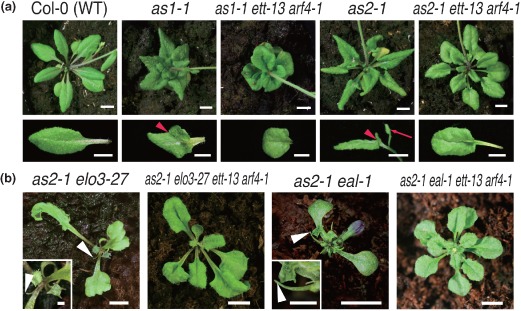Figure 5.

(a) The ett and arf4 mutations suppressed major leaf phenotypes of as1‐1 and as2‐1. Representative gross morphology of 40‐day plants and magnified views of their leaves. Gross morphology of Col‐0 (wild type), as1‐1, as1‐1 ett‐13 arf4‐1, as2‐1, and as2‐1 ett‐13 arf4‐1 plants is shown. The genotype of each plant is indicated. Red arrowheads indicate leaf lobes and the arrow indicates a leaflet‐like structure. The introduction of ett arf4 double mutations into as1‐1 or as2‐1 efficiently suppressed the phenotypes of asymmetrically curled leaf blades, asymmetric lobes, and plump and swelled leaf laminas in both mutants34 in Figure 2(b). Scale bars: 5 mm (upper) and 2 mm (lower). (b) Gross morphology of typical double mutants (as2‐1 elo3‐27 and as2‐1 eal‐1/bob1). Introduction of ett and arf4 mutations into the double mutants efficiently suppressed the abaxialized leaf phenotypes to form flat symmetric leaves. See details of modifier mutations in Table 1. Scale bars: 5 mm. Plants were photographed at 28 days after sowing. White arrowheads indicate filamentous leaves. Scale bars: 5 mm. Higher magnification views of filamentous leaves are shown. Scale bars: 1 mm in higher magnification views. Photographs (a) and (b) are reproduced and modified from Ref 34 (Development 2013, 140:1958–1969) and Ref 69 (Plant Cell Physiol 2013, 54:418–431), respectively.
